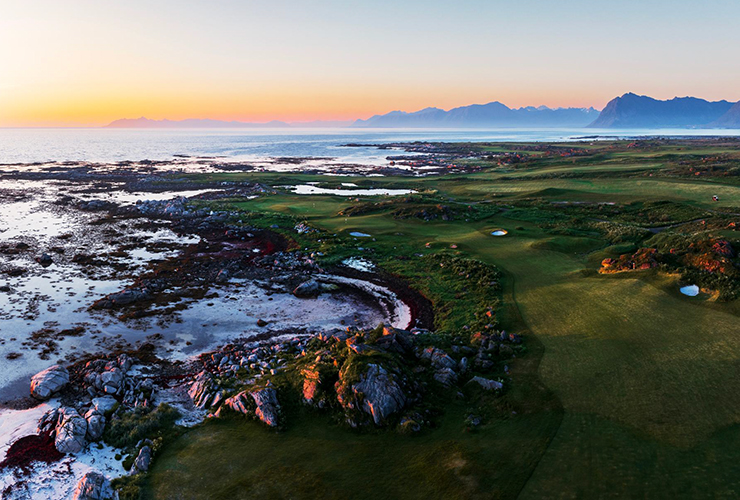These days, new golf courses—especially those that might chart high on national rankings—tend to burst onto the scene with great fanfare. There’s usually a press release announcing the plan to build the next sensational Gil Hanse, Tom Doak, Tom Fazio or Jack Nicklaus design, followed by updates of the construction progress all the way up to the opening, followed by mouthwatering photography, drone videos and reveals on this or that Best New list.
Not so with Lofoten Links. You might say it snuck up on the golf world.
Jaws dropped a few years ago when photographs of Lofoten Links began appearing in magazines and on social media. The course seemed to come from nowhere, as if teleported through dimensions from a beach in Valhalla, with mystical golf holes forged into a tidal landscape of stone and water. Located near Gimsøyand, Norway, well north of the Arctic Circle along the coast of the rocky Lofoten Island archipelago, Lofoten had cooked slowly and quietly, decades in the making.
It began in the early 1990s as the vision of Tor Alfred Hov, who wanted to build an esteemed golf course on the family farm that fronted the Arctic Ocean. When Tor passed away in 1993, his son, Frode Hov, then in his 20s, inherited the audacious vision and pushed forward. The family had been introduced to British architect Jeremy Turner who was active in Scandinavian course design, and he and Hov worked for several years on laying the foundation for a course before finally constructing six short holes on the land in 1998.

Jacob Sjoman
Turner and Hov eventually added three more holes, and around 2010 Hov secured investments to complete a full 18, designed by Turner, with modifications to the existing design. The new Lofoten Links opened in 2015.
A star was born from darkness. Lofoten quickly rose in the international rankings, debuting on Golf Digest’s World’s 100 Greatest Courses at No. 44 in 2022 before rising to No. 24 this year. The course has been an object of fascination and curiosity for those familiar with it, as much for its rugged Norwegian beauty as for the fact that during the summer you can play 24 hours a day since the sun doesn’t set that far north.
As dreamlike as the golf is, attracting visitors to the remote location and transforming Lofoten Links into an A-list global destination has been challenging. Enter the Cabot Collection, the Canadian luxury golf developer.
This month, Cabot announced a strategic partnership with Frode Hov and Lofoten Links, with a plan to invest resources into the operation and to help raise its international profile. Lofoten is the most recent of a slate of Cabot acquisitions that includes Cabot Bordeaux in France, (formerly Golf du Medoc), Cabot Highlands in Scotland (including Castle Stuart and a new Doak-designed course scheduled to open next year) and Cabot Citrus Farms in Florida (formerly World Woods Golf Club).

Jacob Sjoman
“It’s one of the most beautiful places I’ve ever seen in the world, even without the spectacular golf,” says Ben Cowan-Dewar, Cabot co-founder and CEO.
“There are only a few people who are crazy enough to build remote golf in communities where there’s no local market, but I’d heard of Frode Hov and had always been interested in Lofoten Links.”
Cowan-Dewar says he first entertained the idea of adding Lofoten to the Cabot portfolio in 2020, but COVID sidelined the conversation. “When I saw it about five years ago and met Frode on the first hole of his creation, it reminded me of all the time and work and hardship we put into building Cabot Links at Cape Breton almost 20 years ago, in another remote and difficult location. I was just totally taken with it.”
Cabot’s plan in the near term is to enhance and round out the course’s amenities to place Lofoten Links on par with other acclaimed global destination courses. That includes building a larger, permanent clubhouse and adding Cabot-level accommodations and dining. There’s also enough available land on the property to explore a second course. Cowan-Dewar says he believes in Cabot partner Mike Keiser’s belief that one-plus-one (golf courses) equals three—multiple courses have outsize influence on demand.

Jacob Sjoman
“It’s already an amazing place and well worth a visit today,” Cowan-Dewar says. “What Frode Hov has accomplished there in the middle of nowhere is nothing short of remarkable, and right now we’re just going to help them build on the foundation they have. We think we can help chip in on that.”
Ultimately Cabot wants other to experience Lofoten Links in the way Cowan-Dewar did on his first visit.
“We teed off at 11 o’clock at night and the sun never left the sky,” he says. “That’s something I hope we’ll be able to get a bunch of golfers to come see, at least once in their lifetime. It’s one of the wonders of the golf world.”
Main Image: Jacob Sjoman









